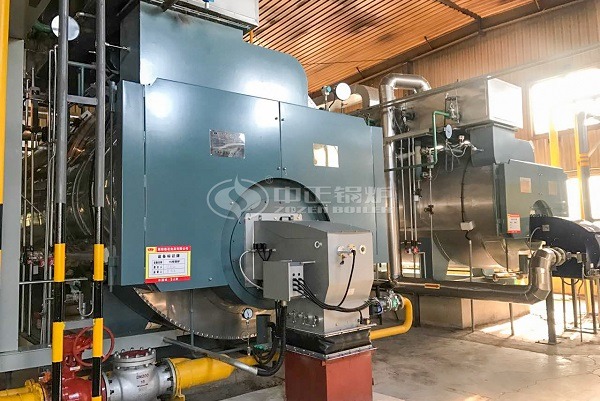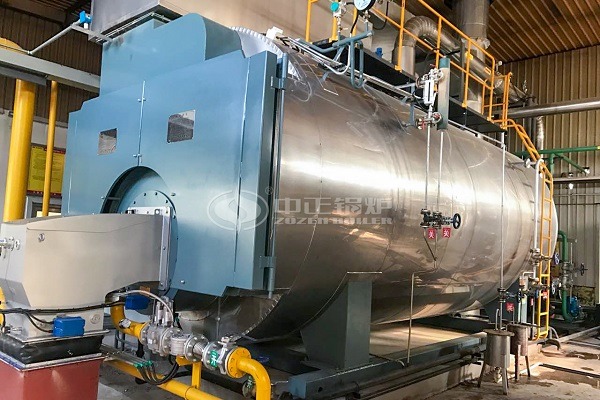The gas-fired steam boiler uses the waste heat of the boiler flue gas to exchange heat with the return water of the boiler. Thereby, the temperature of the return water of the boiler is increased, and the thermal efficiency of the boiler can be increased by 5-10%. WNS20-1.25-Y (Q) steam boiler reduces the temperature stress of the boiler drum and avoids low temperature corrosion of the boiler. It ensures the safe operation of the boiler and greatly prolongs the service life of the boiler.

WNS20-1.25-Y (Q) Steam Boiler Start Boiler
Observe the water level in the water level gauge. If the water level rises or falls, check whether the opening and closing positions of the water supply valve and the drain valve are correct or leaking. When the pressure rises to 1 kg force (cm 2 ) gauge pressure, the water level gauge should be flushed. The sequence of flushing the water gauge is as follows:
- Open the soda water cock and flush the soda water connecting pipe;
- Close the water cock and flush the steam connection pipe;
- Open the water cock and flush the soda water connection pipe;
- Close the steam cock and flush the water connection pipe;
- Open the steam cock and flush the soda water connection pipe;
- Close the soda tap to return the water level to normal.
If the water level rises rapidly and fluctuates slightly, the water level is normal. If the water level rises very slowly, indicating that the water level gauge is blocked, it should be flushed and checked again. When the pressure rises to 2 kg force (cm 2 ) gauge pressure, flush the pressure gauge trap.
When the pressure rises to 3 kg force (cm 2 ) gauge pressure, check whether there is any leakage at the joints of the pressure-bearing parts, and then tighten the loosened screws again. In order to prevent the screw from being broken, the force should not be too strong and the method of lengthening the handle is not allowed to fasten the screw.
When the pressure rises to 4 kg force (cm 2 ) gauge pressure, a blowdown is performed to balance the temperature of the boiler water in each part. Before the sewage is discharged, the water should be brought to a high water level. When the sewage is discharged, pay attention to observe the surrounding conditions of the sewage pipeline, and observe the water level at any time. After the sewage is discharged, the sewage valve should be closed tightly and check whether there is any water leakage.
When the pressure rises to 2/3 of the working pressure, warm the pipe (the purpose of the warm pipe: make the steam pipes, valves, flanges, etc. are heated evenly and slowly, and drain the condensed water in the pipes to prevent water hammer in the pipes. And leakage occurs, etc. The heating time is about half an hour. The operations are as follows:
- Open the trap on the pipeline to remove all condensed water.
- Slowly open the main steam valve for half a turn, and fully open it after the pipeline is fully preheated. If there is vibration or water hammer in the pipeline, the main steam valve should be closed immediately to strengthen the drainage. After the vibration, slowly open the main steam valve and continue to warm the pipe.
- Slowly open the steam inlet valve of the sub-cylinder to make the steam pressure of the pipeline equal to the steam pressure of the sub-cylinder, and pay attention to remove the condensed water.
- Until the dry steam is discharged, close all traps and fully open the main steam valve. After each steam valve is fully opened, it should be rotated half a turn to prevent the steam valve from being stuck due to thermal expansion.

WNS20-1.25-Y (Q) steam boiler is simple in structure and easy to use. It is easy to repair and maintain and effectively prolong the service life of the boiler. It ensures that the output of the boiler can also make the heat exchange load uniform and stable, which is beneficial to the steam-water circulation on the working medium side and improves the safety of the boiler.
The gas-fired steam boiler adopts a spring-type explosion-proof device. The spring-type explosion-proof door has both explosion-proof and inspection functions at the same time, and is composed of two parts: the door seat and the moving slider. The door seat is equipped with refractory bricks. When the furnace is overpressured, the pressure will push the refractory block to discharge it out of the door seat. Not only does it have the effect of releasing pressure, but it will not cause harm to external facilities and people, and it can automatically return to its position after the release is completed. The bricks can also be taken out when the furnace is overhauled, which is convenient for operators to enter the furnace. This design not only can safely vent the explosion, but also avoids the trouble of replacing the venting plate, and plays a role of safety, reliability and convenient main tenance in the operation of the entire steam boiler.